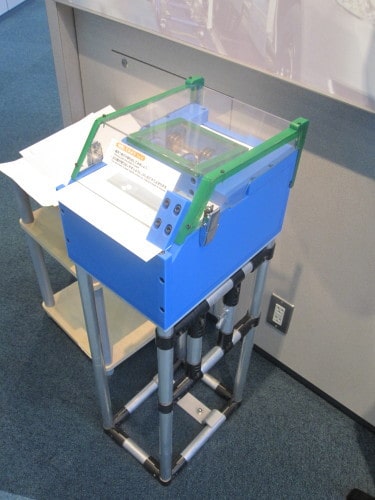Reflecting more on my recent Japan tour (see previous posts) one word came up in my notes: artifacts.
One dictionary definition of that term is straightforward: “any object made by human beings, especially with a view to subsequent use.”
Another is a bit more thought provoking and is relevant to study tours like this:
“a spurious observation or result arising from preparatory or investigative procedures.”
Our guides from Kaizen Institute had good advice about not taking back artifacts of Lean and the Toyota Production System.
They didn't mean “don't steal kanban cards from Toyota to take home with you” (that would have been hard, anyway, from a mezzanine tour).
They meant “don't copy a specific practice or method that you see because you think that's Lean and that will make you Lean.”
Lean is about a way of thinking – a management system and an improvement methodology that engages everybody… continuous improvement and respect for people.
One artifact we saw at the Toyota plant:
- Workers had break areas right adjacent to the assembly line
- They had a table and team boards that displayed performance measures, etc.
- Instead of lockers, each worker had a stool that was more like an ottoman where the seat lifted up on a hinge to reveal storage space for personal items
An “industrial tourist” (a term used with appropriate disdain by followers of W. Edwards Deming) might go stomping through a factory to collect artifacts and tools. I preferred to think of our trip as a “study mission” as we were talking about the thinking process and philosophy of Lean far more than tools.
 When we see a tool or method, it's good to ask what problem that tool is solving and what the thought process behind it might be.
When we see a tool or method, it's good to ask what problem that tool is solving and what the thought process behind it might be.
An industrial tourist might enthusiastically come home and declare to their factory (in a top-down way), “we're getting rid of lockers and getting storage stools!!! We'll be Lean!!!”
Toyota's methods worked for them. Beyond the artifacts, they might display other Lean thinking concepts, like visual management, waste reduction (avoiding long walks to a break area, and respect for people.
We can be inspired by the thinking and the creativity of places like Toyota without literally copying everything we see.
The Toyota museum in Nagoya had quite a large display on the Toyota Production System. They gave credit to their workers and displayed simple Kaizen or error proofing (poka yoke) devices that had been created.
This is a clever mechanical device that always spits out one piece of paper in a way that's easy to grab, even with a worker wearing gloves.
This is an artifact, but it visualizes many Lean thought processes — respect for people, making work easier for people, systematically preventing errors rather than telling people to just be careful, engaging people in kaizen and creativity…
Those are wonderful things to copy, those thoughts.
I was teaching a Lean healthcare course last week via the ThedaCare Center for Healthcare Value (to be repeated in March) and a hospital laboratory director talked about some consultant who was very dogmatic that their core lab area must have no chairs. “No chairs” is an artifact of process improvement in many Lean lab settings.
“No chairs” is often the natural extension of other Lean improvement work and it's often prompted by the medical technologists (the ones doing the work, in this case). When lab machines are arranged in a U-shaped cell (that shape also being an artifact that somebody might copy) and technologists are fully cross trained, people aren't just parked in front of the same machine all day. Chairs often get in the way. Getting up and down from chairs (or stools) constantly isn't really good ergonomically, either.
But “no chairs” doesn't mean “don't have a place to sit down and rest when you have the chance.” The misunderstood artifact (devoid of Lean thinking) might be to eliminate all chairs and to never sit down. That's crazy. Of course, the lab director said she would have a revolt if she took away the chairs. But, if the workers decide to get the chairs out of the way, that would be OK and that might be a good example of Lean thinking.
No chairs? Remember, the Toyota assembly line had stools very close to the assembly line… for rest in the break area (and “respect for people” means we let people take proper breaks and stop to have lunch…).
- No chairs –> artifact
- Chairs with storage –> artifact
- Putting tape around staplers –> artifact
Copying artifacts, without critical thinking, leads to ridiculous situations like this video I made illustrates. Seeing an artifact might be a “spurious observation” based on a superficial walk through a factory.
As the one hospital CEO we visited said “Think for yourself and take action.” That was their quality improvement theme for the year… not “Visit Toyota and copy artifacts.”
Learn about future tours:
Please scroll down (or click) to post a comment. Connect with me on LinkedIn.
Let’s build a culture of continuous improvement and psychological safety—together. If you're a leader aiming for lasting change (not just more projects), I help organizations:
- Engage people at all levels in sustainable improvement
- Shift from fear of mistakes to learning from them
- Apply Lean thinking in practical, people-centered ways
Interested in coaching or a keynote talk? Let’s talk.
Join me for a Lean Healthcare Accelerator Trip to Japan! Learn More













I continue to be amazed at healthcare’s often blind attempt to adopt anything Lean they saw at their last plant tour.
Sure, there are some universal aspects of Lean that rightly should be adopted.
On the other hand, if we look at some of the really really good stuff that Virginia Mason (patient safety alert system) and ThedaCare (collaborative care, leader standard work) have done, we find that they took a principle not an artifact and made something that added value to them. It takes a much deeper level of leadership understanding to do these kinds of things than we see with many of the cookie cutter approaches.
I couldn’t agree more Mark. I like the phrase “study Toyota don’t copy them”. This forces us to think about the application and what problem was Toyota trying to solve when they came up with this countermeasure. If we don’t have the same problem, why would we try the same countermeasure?
That’s right, Al. I guess some kind of reverse engineering (solution -> cause(s) -> problem) can be a reasonable way to go when observing/studying Toyota artifacts (or artefacts as my British spell checker suggests ;)).
[…] Lean healthcare guru and Shingo prize winner Mark Graban reflects on his trip to Japan: Taking Home Lean Artifacts or Lean Thinking? […]
I’m working with Kaizen Institute to do another Lean Healthcare study trip to Japan, the week of November 17. 2014.
Contact me if you’re interested in learning more.
[…] Japan Tour Reflections: Taking Home Lean Artifacts or Lean Thinking? […]
Comments are closed.